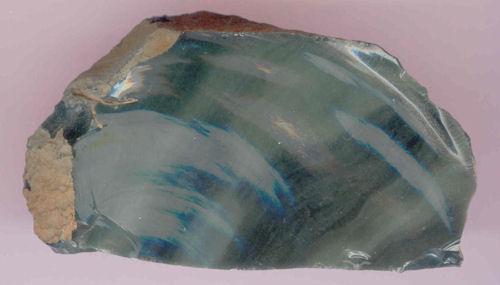

|
Obsidian is a naturally-occurring volcanic glass and is probably one of the most widely recognized rocks or minerals. The name obsidian is one of the most ancient of rock names still in use today and was brought into the language by Pliny (the Elder) almost two millenia ago. Iddings (1888:261) writes that the stone was named after "...Opsius, its discoverer, in Ethiopia, according to Pliny, who says that when laid in chamber walls in the form of mirrors it reflects shadows instead of images." The term obsidian is a textural one and the chemical composition of the glass can vary from basaltic (low-silica) to rhyolitic (high-silica). Since the obsidians of varying compositions are often megascopically indistinguishable, they are correctly all lumped into this one category: obsidian. If the composition is known, however, the term obsidian should be preceded by the appropriate rock name as defined by silica content, i.e. basaltic, andesitic, dacitic or rhyolitic. Though the composition of obsidians is variable, the vast majority are rhyolitic in composition, the reason for this being related to the high viscosity of high-silica melts.
|
|
Adams, Rex K. 1980. Debitage Analysis: Lithic Technology and Interpretations of an Archaic Base Camp Near Moquino, New Mexico. Unpublished Master's Thesis, Department of Anthropology, Eastern New Mexico University, Portales, New Mexico. American Geological Institute. No Date. AGI Data Sheets. American Geological Institute. Bates, Robert L. and Julia A. Jackson. 1987. Glossary of Geology. American Geological Institute, Alexandria, Virginia. Bowman, Kathleen K. 1987. An Analytic Study of Obsidian from the Middle Rio Puerco Valley, New Mexico. Unpublished Master's Thesis, Department of Anthropology, Eastern New Mexico University, Portales, New Mexico. Clark, Bruce R. 1970. Stress-Controlled Orientation of Microlites in Obsidian. EOS 51(4):425. Clark, Donovan L. 1961. The Application of the Obsidian Dating Method to the Archaeology of Central California. Unpublished Ph.D. Dissertation, Stanford University, Palo Alto, California. Dana, James. 1959. Dana's Manual of Mineralogy, 17th edition revised by C.S. Hurlbut, Jr. John Wiley & Sons, Inc., New York, New York. Goddard, E.N., Parker D. Trask, Ronald K. DeFord, Olaf N. Rove, Joseph T. Singewald, Jr., and R.M. Overbeck. 1980. Rock-Color Chart. Geological Society of America, Boulder, Colorado. Haarklau, Lynn, Lynn Johnson, Dave Wagner, Richard E. Hughes, Craig E. Skinner, Jennifer J. Thatcher, and Keith Myhrer. 2005. Fingerprints in the Great Basin: The Nellis Air Force Base Regional Obsidian Sourcing Study. Report prepared by Prewitt & Associates, Inc., Austin, Texas, for Nellis Air Force Base, Nevada. Heinrich, E. Wm. 1956. Microscopic Petrography. McGraw-Hill Book Co., New York, New York. Heizer, Robert F., Howel Williams, and John Graham. 1965. Notes on the Mesoamerican Obsidians and Their Significance in Archaeological Studies. In Sources of Stones Used in Prehistoric Mesoamerica Sites, Contributions of the University of California Archaeological Research Facility 1: 94-103. Iddings, Joseph P. 1888. Obsidian Cliff, Yellowstone National Park. U. S. Geological Survey Seventh Annual Report 3:249-295.
Johannsen, Albert. 1931.
Kuenen, Ph. H. 1956. Experimental Abrasion of Pebbles: 2. Rolling by Current. Journal of Geology 64:336-368.
Landis, Daniel G. and Robert L. Sappington. 1985. Appendix J: Obsidian Sourcing Analysis. In A Cultural Resources Survey and Site Testing of the Bonneville Power Administration's Malin-Warner 240kV Transmission Line, Klamath County, Oregon, and Modoc County, California, edited by M.J. Rodeffer and Jerry R. Galm, pp. 537-558. Eastern Washington University Reports in Archaeology and History 100-36, Cheney, Washington.
MacLeod, N. 2002. Geometric Morphometrics and Geological Form-Classification Systems. Earth-Science Reviews 59:27-47
O'Keefe, John A. 1976. Tektites and Their Origin. Elsevier Publishing Co., New York, New York.
Pettigrew, Richard M. 1983. Archaeological Investigations at the Wagontire Site (35HA328), Harney County, Oregon. OSMA Survey Report 83-4, University of Oregon, Eugene, Oregon.
Pettigrew, Richard M. and Clayton G. Lebow. 1987. Data Recovery at Sites 35JA27, 35JA59, and 35JA100, Elk Creek Lake Project, Jackson County, Oregon. Report prepared for the U.S. Army Corps of Engineers by INFOTEC Research, Eugene, Oregon.
Pettijohn, F. J. 1975. Sedimentary Rocks. Harper & Row, Publishers, New York, New York.
Powers, M. C. 1953 A New Roundness Scale for Sedimentary Particles. Journal of Sedimentary Petrology 23:117-119.
Ross, Clarence S. 1962. Microlites in Glassy Volcanic Rocks. American Mineralogist 47:723-740.
Rutley, Frank. 1891. Notes on Crystallites. Mineralological Magazine 9(44):261-271.
Shelley, Phillip H. 1993. A Geoarchaeological Approach to the Analysis of Secondary Lithic Deposits. Geoarchaeology 8:59-72.
Skinner, Craig E. 1983. Obsidian Studies in Oregon: An Introduction to Obsidian and An Investigation of Selected Methods of Obsidian Characterization Utilizing Obsidian Collected from Prehistoric Quarry Sites in Oregon. Unpublished Master's Project, Interdisciplinary Studies, University of Oregon, Eugene, Oregon.
Skinner, Craig E. 1987. Lithic Database Project: Software Documentation. Unpublished manuscript in possession of the author.
Skinner, Elizabeth J., John L. Fagan, and Peter W. Ainsworth. 1989. Lithic Landscape: Technological Constraints of Size Shape and Amount of Cortex. Paper presented at the 47th Plains Conference, Sioux Fall, South Dakota, October, 1989.
Suzuki, Masao. 1973. Chronology of Prehistoric Activity in Kanto, Japan. Journals of the Faculty of Science, Unievrsity of Tokyo, Section 5 (Anthropology) 4(Part 3):241-318.
Williams, Howel, Francis J. Turner, and Charles M. Gilbert. 1954. Petrography: An Introduction to the Study of Rocks in Thin Section. W. H. Freeman and Co., San Francisco, California.
Zirkel, Ferdinand. 1987. Microscopic Petrography. Professional Papers of the Engineer Department, U. S. Army, No. 18, Report on the Geologic Exploration of the Fortieth Parallel, Vol. 6.
|